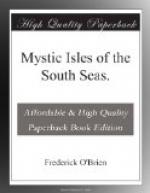We all sat on the mats according to bodily habit, the lithe natives on their heels, the grosser ones and we whites with legs crossed, and with the minister’s raising of his head we fell to, with ease of position, and no artificial instruments to embarrass our hands. We transferred each to his own breadfruit-leaves what he desired from the stores in the center, meat and vegetables and fruit, and seasoned it as we pleased. New leaves brought by boys and girls constantly replaced used ones, and the shells of salt and fresh water were refilled.
Barrels of white and red wine had been decanted into bottles, and with American and German beer stood in phalanges beside the milky banana columns, and from these all replenished their polished beakers of the dark nuts.
The oysters, of a flavor equaling any of America or Europe, were minute and of a greenish-copper hue, and we removed them with our tongues, draining the ambrosial juice with each morsel, and ate twenty or thirty each. The fish was steeped in lime-juice, not cooked, and flavored with the cocoanut sauce and wild chillies. The crayfish were curried with the curry plant of the mountains, the shrimp were eaten raw or boiled, and the goldfish were baked.
The sucking pig and fowl had been baked in a native umu, or oven, on hot stones, and the taro and yams steamed with them. Taro tops were served with cocoanut cream. One was not compelled by any absurd etiquette to choose these dishes in any sequence. My left-hand neighbor was indifferent in choice, and ate everything nearest to him first, and without order, taking feis or bananas or a goldfish, dozens of shrimps, a few prawns, a crayfish, and several varos, but informing me, with a caress of his rounded stomach, that he was saving most of his hunger for the chicken, pig, and poi. He was a Tahitian of middle age, with a beaming face, and happy that I spoke his tongue. When the pig and poi were set before us, he devoured large quantities of them. The poi was in calabashes, and was made of ripe breadfruit pounded until dough with a stone pestle in a wooden trough, then baked in leaves in the ground, and, when cooked, mixed with water and beaten and stirred until a mass of the consistency of a glutinous custard. He and I shared a calabash, and his adroitness contrasted with my inexperience in taking the poi to our mouths. He dipped his forefinger into the poi, and withdrew it covered with the paste, twirled it three times and gave it a fillip, which left no remnant to dangle when the index was neatly cleaned between his lips. Custom was to lave the finger in the fresh-water shell before resuming relations with the poi.
My handsome neighbor ate four times as much as I, and I was hungry. His appetite was not unusual among these South Sea giants. I noticed that he ate more than three pounds of pig and a quart of poi after all his previous devastation of shellfish, feis, chicken, and taro, besides two fish as big as both my hands. My right-hand neighbor was Mr. Davey, an urbane and unreserved American, who informed me in a breath that he was a dentist, a graduate of Harvard University, seventy-two years old, and had been in Tahiti forty-two years. He called his granddaughter of eighteen to meet me, and she brought her infant. Only he of his tribe could speak English, but she talked gaily in French.




